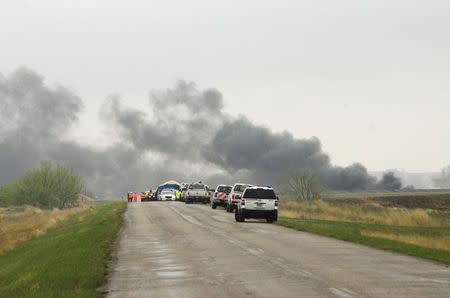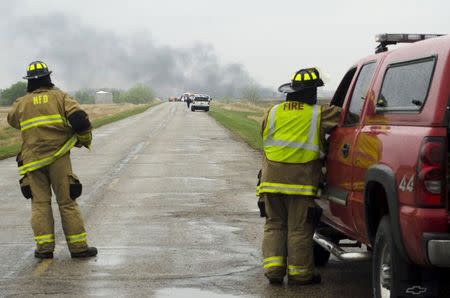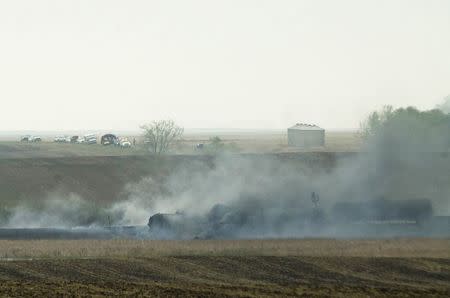Small town evacuated after oil train derails in North Dakota
By Ernest Scheyder and Kristen Hays WILLISTON, N.D./HOUSTON (Reuters) - A BNSF train carrying crude oil owned by Hess Corp derailed and caught fire in North Dakota on Wednesday, forcing the evacuation of a nearby small town just days after the United States and Canada announced reforms to improve the safety of such shipments. About 40 residents from the tiny Wells County town of Heimdal were evacuated after 10 tank cars left the rails, fire officials and the state's emergency management agency said. There were no injuries, officials said. Black smoke was visible for miles just after the early-morning accident as more than 300,000 gallons of crude oil burned. Emergency responders from five communities set up a command center near scorched wheat fields adjacent to the train tracks as a steady rain fell, a Reuters photographer said. By evening, crews were erecting berms to protect nearby wetlands and preparing foam to attempt to smother the last of the flames. However, officials still had not lifted the evacuation order. The crude oil was loaded into Hess-owned railcars at the oil producer's crude-by-rail facility in Tioga, roughly 170 miles (270 km) to the northeast. A BNSF locomotive met the 109 cars, two of which carried sand; the rest were filled with crude. Heimdal is located along one of the main rail lines heading east out of the state's giant Bakken oil patch. About two-thirds of all North Dakota oil production is shipped by rail, three-quarters of that to refiners on the U.S. East Coast. Just last Friday, the U.S. Department of Transportation and Canada's Transport Ministry announced new rules for oil trains, including phasing out older tank cars, adding electronic braking systems and imposing speed limits. The measures were all meant to reduce the frequency and severity of oil train crashes. BNSF said the tank cars involved were non-jacketed CPC-1232 models, which the new rules will render obsolete within five years. BNSF is leading remediation efforts, although Hess said it stands ready to assist. The National Transportation Safety Board said it would send a team to the site. Heimdal is one of the many small towns that dot the central North Dakota landscape and have co-existed with rail lines for decades. It has only seven streets and directly abuts the BNSF line, which has a spur to offload grain and other commodities. NEW RULES New state rules that took effect last month mandate that most natural gas liquids (NGLs) be removed from North Dakota oil before shipment, though the quality of the crude in this incident is not yet known, said Cecily Fong of the state's Department of Emergency Services. Hess told Reuters that it is "fully compliant" with the new standards, which are designed to mitigate the incendiary effect of crude-by-rail disasters. Witnesses described a relatively subdued scene compared with oil tankcar derailments that had occurred before the standards took effect. "The scene is very anticlimactic and rather nondramatic, which is all very good," Congressman Kevin Cramer (R-N.D.) said in an interview after leaving the site. The derailment occurred at 7:30 a.m. between Hamburg and Heimdal. The locomotive engine and 99 tank cars not affected were unhitched and moved away, Fong said. On the non-jacketed CPC-1232s - involved in Wednesday's derailment - William Furman, chief executive of railcar manufacturer Greenbrier Cos, said in a recent interview that they are as dangerous as older cars if they derail and ignite, causing a ripple effect of fire and explosions. "If they roll, release and ignite from friction or drag, they will ignite others that aren't jacketed or insulated," Furman said. Furman also noted that before the domestic shale oil boom, railcars carrying crude were typically interspersed with others carrying non-flammable cargoes in mixed-freight trains, similar to the way more flammable liquid petroleum gases (LPG) are currently moved via rail. LPGs move in stronger pressurized railcars long designed to withstand derailments – and if they do rupture, they are not part of an LPG-only train that could lead to more explosions. Crude-only unit trains emerged from vastly increased U.S. production and use railcars that were not intended to move flammable liquids in such high concentrations, he said. PREVENTING DERAILMENTS Still, other experts said railroads must do a better job of upgrading their existing networks to prevent derailments in the first place. "We can make our tank cars as robust as possible, but that's not the issue," said Brigham McCown, who ran DOT's Pipeline and Hazardous Materials Safety Administration from 2005 through 2007. "The issue is keeping the trains on the tracks." The volume of crude oil by rail has rocketed in recent years as production increases from areas such as North Dakota has outpaced pipeline development. A spate of explosive accidents has accompanied that growth. The worst was in July 2013 when a train derailed in the town of Lac Megantic in Canada, killing 47 people. Already this year, five trains have derailed and caught fire in the United States and Canada, all in rural areas. There have been no deaths, but the accidents have stoked concerns about the safety of transporting crude oil by rail. (Reporting by Ernest Scheyder in Williston, Kristen Hays in Houston and Edward McAllister in New York; Editing by Frances Kerry and Ken Wills)





